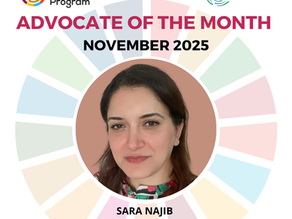How to be a Sustainable International Educator while being a Global Schools Advocate
- SDSN Youth

- Mar 13, 2023
- 3 min read
Written by Ma. Jonaper P. Palmares, Global Schools Advocate from Libya

As a Global Schools Program (GSP) Advocate, a content creator (Study Time with Miss M), a Hilokal language trainer (South Korean language learning app), and Social Studies teacher at the First Philippine International School in Libya, my vision is to establish a network of educational pathways beyond the four walls of the classroom which causes a societal impact around the world through the use of Education for Sustainable Development (ESD).
For me, being a sustainable international educator means being a teacher with the ability to align interests, strengths, and values to offer ongoing learning and renewal. Based on my experience, I would like to share my tips on how to be a sustainable international educator for all of those who are also teaching abroad.
Value the Cultural Immersion
Integrating myself into another culture through interaction with locals has given me a deeper understanding of how others live. I used to teach South Korean students when I was in the Philippines years ago, and I've experienced their rigorous way of learning. On the other hand, my Libyan students love a more hands-on approach. Although both nationalities have different lifestyles, they match with values that are essential in problem-solving and collaborative tasks.
As a sustainable international educator, one must possess cultural adaptability through immersion to allow seeing the world's perspectives and interconnectedness with each other to make a positive change.

Use the L.E.A.R.N Technique (Launch, Engage, Attend, Read, Narrate)
Michaelangelo's famous quote, "Ancora Imparo- I am still learning," resonates with the second tip, which means that one must look at every day as something new, learn something new, and do something new.
Launch a project, engage by attending workshops/ seminars and reading anything in connection with it while narrating to others your progress. Learning becomes successful through application by passing the concepts to others.
This technique which I devise has been effective for my students for me to know if they have learned the lessons. Last month, they set up businesses on their annual school bazaar. They sold food and drinks and set up gaming booths for the children. The whole event became a successful project that other international schools followed it.

Innovate through Virtual Connectivity
Scientific advancements have paved the way into a new era of technology, and as a Global Schools Advocate, social media is seen as an enabler and driver of innovation in teaching ESD.
Last semester's interaction with my mentors and fellow advocates is an example of how effective social media is in facilitating communication and information sharing. Currently, I am using different platforms to interact with other learners across the globe. During my free time, I use Hilokal (A south Korean language learning app) to integrate the English language and ESD, as well as to give awareness about the Sustainable Development Goals.
Final Takeaway
To live abroad and work in an international school is an opportunity of a lifetime to hone skills and establish professional satisfaction. It serves as a way into different avenues of discovery and learning to make a difference.
As I quote Robert Frost's Road Not Taken, "I took the one less traveled by, And that has made all the difference." As I walk independently with this path while celebrating my 11th year of teaching Libyan and foreign learners, may this blog post be an inspiration to all advocates to join me in the long run as catalysts of change.
Learn more about Ma. Jonaper P. Palmares's efforts in advocating for SDGs on her YouTube channel.

















Comments